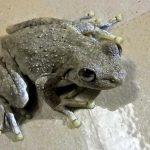PERON'S TREE FROG
The Peron’s tree frog, also known by its more whimsical names like the Emerald-spotted tree frog and the Laughing tree frog, is a fascinating creature that brings a touch of the extraordinary to the Australian landscape.
Imagine a small amphibian, typically reaching about 4.5 to 6.5 centimetres in length. Its most striking feature is its skin, which is adorned with tiny, iridescent green spots that catch the light, giving it the nickname “Emerald-spotted.” The rest of its body is usually a mix of grey and brown, allowing it to blend seamlessly into its surroundings. It has a unique toe structure that allows it to climb smooth surfaces, making it an excellent climber. Despite their small size, these frogs are quite resilient and can often be found in urban gardens, where they play a crucial role in controlling insect populations.
This adaptable frog is found along the eastern coast of Australia, from northern Queensland down to Victoria. It thrives in a variety of habitats, including woodlands, forests, and even urban areas, as long as there is water nearby for breeding. These frogs can live for several years, although exact lifespan data can vary.
Peron’s tree frogs are insectivores, meaning they primarily feast on insects. Their diet includes moths, beetles, and other small invertebrates, which they catch with their quick, sticky tongues.
The breeding season for these frogs typically occurs during the warmer months, from late spring to early summer. Males gather near water bodies and call out with a distinctive, almost maniacal cackle to attract females. Once paired, the female lays eggs in water, which hatch into tadpoles before undergoing metamorphosis into frogs.
Currently, the Peron’s tree frog is listed as Least Concern by the IUCN. This status is due to its wide distribution and adaptability. However, like many amphibians, it faces threats from habitat destruction, climate change, and pollution.
The Peron’s tree frog is often called the Laughing tree frog due to its distinctive call, which sounds like a series of rapid, high-pitched cackles. This sound can be quite loud and is often heard during the evening and night.
The Peron’s tree frog is a delightful example of Australia’s diverse wildlife. Its adaptability and charming presence make it a beloved creature among those who are lucky enough to encounter it. As with all wildlife, appreciating and protecting their natural habitats is key to ensuring these frogs continue to thrive for generations to come.

